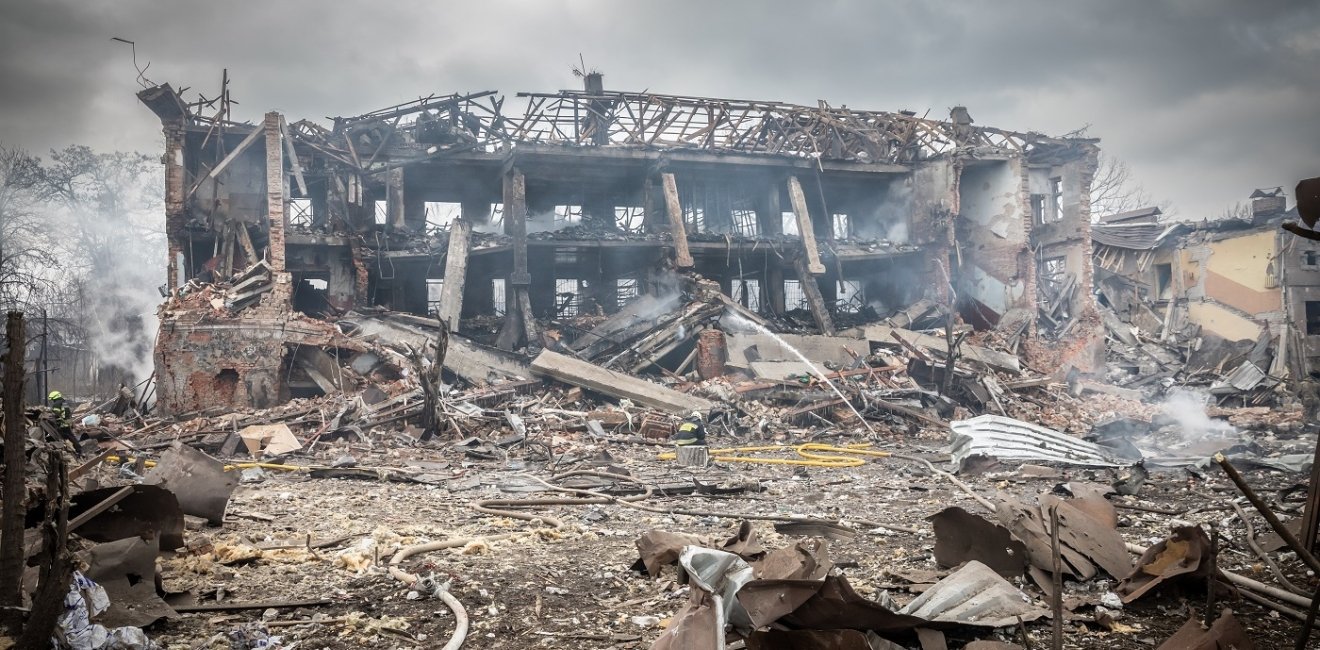
A blog of the Kennan Institute
BY MYKHAILO MINAKOV
Russia’s war against Ukraine has gone on for almost three months. During this period Russia’s military campaign has shifted from a blitzkrieg style of attack aimed at fast regime change in Kyiv to a longer-term war of attrition. Ukraine’s military strategy has undergone a similar evolution. The government’s initial plan involved total and uncompromising defense at any cost on all fronts—including military, financial, information, and diplomatic. These strenuous efforts worked rather well: Ukraine demonstrated huge resilience in the face of the invasion, won the battle for Kyiv and for northern Ukraine, and inspired the West to provide the Ukrainian army with increasingly sophisticated weapons.
The Context of the Debate
Changes in the pacing and the theaters of the conflict have handed Ukraine’s leadership another problem, adapting the government’s military, political, and economic policies for a much longer war of attrition.
From a military point of view, the security and defense arm of government has improved its strategic operations planning and increased arming and staffing of the army operating in key areas of the front. This has already brought results. In the south, the Russian Black Sea Fleet is considerably weakened, while Ukrainian forces in Odesa and Mykolaiv are growing stronger. In the northeast, Ukrainian forces won the battle for Kharkiv and strengthened the defensive infrastructure on the Russian border. The pace of Russian attacks in the northern Donbas has considerably slowed.
Politically, Ukraine has tremendously increased its cooperation with the G7 countries, the United States, the EU, NATO, and the UK. Kyiv has become a must-visit capital for Western leaders and delegations. Despite the ongoing conflict, President Zelensky and his team have managed to move forward with Ukraine’s application for EU candidacy, establish an advanced dialogue with Western leaders and societies, and stick fast to the idea of integrating with—or even joining—NATO. Zelensky’s government has shown the Kremlin that Ukrainians will fight to fashion a future settlement on Ukraine’s terms, however close or distant that future might be.
Meanwhile, the government has sought to balance the armed forces’ needs for matériel and munitions to increase the likelihood of a military victory in the distant future and the current pressing needs of the Ukrainian people. Even while engaged in a protracted war of attrition, official Kyiv needs to develop at least a medium-term socioeconomic policy that simultaneously enables the army’s progress, the population’s survival, and the country’s development.
Immediately after the Russian invasion of Ukraine, the Ukrainian government declined to enforce tax collection on small businesses and citizens; offered relief to the country's crippled economy, operating under shelling and martial law; and eased the regulatory regime for job providers. The National Bank of Ukraine froze the exchange rate, restricted cash withdrawals, and limited most cross-border transactions.
However, all these measures did not prevent inflation from rising over 13 percent (year-over-year) in March 2022. Ukraine’s GDP will probably decrease by up to 45 percent by the end of this year. The finance minister estimated the monthly losses of Ukraine’s economy—with up to half of companies terminating their business, a decrease in metallurgical and agricultural exports, and depressed customs revenues—at around $5 billion (or 5 percent of GDP) monthly. Since the beginning of the war, Ukrainians have lost 4.8 million jobs (out of 16 million jobs existing in January 2022), which may push nine out of ten people in Ukraine into poverty or near poverty.
Now that the tempo of the war has changed, the Ukrainian government has started working on a plan for socioeconomic development based on the assumption that the war may go on for another two to three years. If that happens, the kind of resilience that Ukrainians displayed in the first months of the war can be kept alive only if it is supported by a solid economic foundation. Serhiy Marchenko, Ukraine’s minister of finance, has recently acknowledged that the accumulating economic issues are forcing the government to change its economic policies. And this is exactly where the debate between the government and experts is joined.
Socioeconomic Development during Wartime: A Lively Debate
One of the approaches to development during wartime is to create a “war economy” with a strong tax discipline and a big role for government. As Minister Marchenko said, a prolongation of the military conflict for more than three months would require painful measures, including a sharp increase in taxes, cuts in social spending, the possible nationalization of some sectors critical for defense, and the continuing financial support of Ukraine’s allies.
Other voices, not necessarily contradicting that position, call for active measures that would turn the growing numbers of unemployed Ukrainians, refugees, and internally displaced persons from a liability on the state’s ledgers into an economic asset. As the country’s reconstruction projects get under way, labor of all kinds will be needed, some part of which may be supplied by refugees and local populations, which would contribute to an economic rebound while providing financial security to participants. Such an ambitious national welfare program would depend on focused initiatives by the central government and regional administrations, with strong financial support from the Western powers.
Yet others, such as Pavlo Sheremeta, Ukraine’s ex-minister of economic development and trade, use the momentum for development to propose a neoliberal reform of the economy along the lines of the Israel model. According to this model, a country with limited resources can progress and provide its people with a social safety net during long periods of conflict if its economy is open to innovation, encourages entrepreneurship, and has financial support from the West.
These positions offer different solutions to the dilemma of economic development during wartime, but generally all agree on the need to start reconstruction early with the support of Ukraine’s Western allies. In this debate, they try to influence the current cabinet’s reconstruction planning.
A Program for Reconstruction
Already in April 2022, Prime Minister Denis Shmyhal announced a Marshall Plan style of “reconstruction planning” and talks with Western governments on creating a recovery fund. That same month an international group of well-known economists offered its views on priorities for a reconstruction program in Ukraine, rightly stating that such a program should put in place emergency response measures, act rapidly to restore critical infrastructure and services, and lay the groundwork for future modernization. The reconstruction program thus is evolving into a set of policies that would be responsive to the short-, intermediate-, and long-term goals of Ukraine.
The reconstruction program is still far from being agreed upon. But debate around it widens. Under discussion are not only the different policy approaches outlined above but also how the program is to be funded and which agency should control the program.
Currently, the European Commission and the governments of the EU member states are discussing allocating around €15 billion to the program. The United States and the G7 have pledged up to $24 billion additionally. However, European politicians estimate that up to €500 billion will be needed, with no clear answer as to the sources of such funding emerging so far.
In addition, there are divergent views on the timing of such a program: while the experts would like to get started on an urgent basis with reconstruction of critical infrastructure, Ukraine’s Western partners see reconstruction starting after the end of hostilities.
Finally, governance of the reconstruction program would need to be crafted in such a way as to satisfy both President Zelensky’s team, whose authority in a time of war has been unquestioned, and Western donors. Concerns over the appropriate control of future funding supplied to help Ukraine rebuild have already been voiced in the Senate. My sources in the cabinet say that Ukrainian officials, having learned from past mistakes, are preparing a serious program implementation and budget oversight model that would ensure the public’s and donors’ trust in the program.
The vital consequences of the war in Ukraine are measured in lives lost and thrown off course both by military actions and by the numerous socioeconomic implications of a war that has affected every person in Ukraine. Ukraine’s leadership must find the wisdom to resolve the dilemma and achieve both military victory and progress on the socioeconomic front as it looks forward to rebuilding.
The opinions expressed in this article are those solely of the authors and do not reflect the views of the Kennan Institute.
Author


Kennan Institute
After more than 50 years as a vital part of the Wilson Center legacy, the Kennan Institute has become an independent think tank. You can find the current website for the Kennan Institute at kennaninstitute.org. Please look for future announcements about partnership activities between the Wilson Center and the Kennan Institute at Wilson Center Press Room. The Kennan Institute is the premier US center for advanced research on Eurasia and the oldest and largest regional program at the Woodrow Wilson International Center for Scholars. The Kennan Institute is committed to improving American understanding of Russia, Ukraine, Central Asia, the South Caucasus, and the surrounding region through research and exchange. Read more

Explore More in Focus Ukraine
Browse Focus Ukraine
Talking to the Dead to Heal the Living

Ukrainian Issue in Polish Elections


